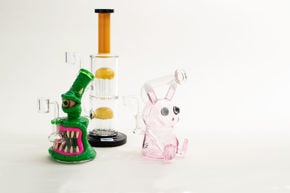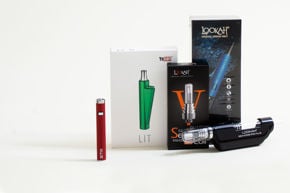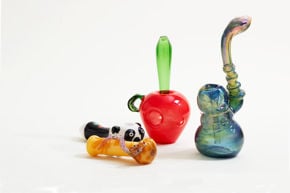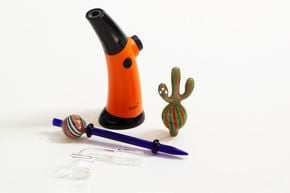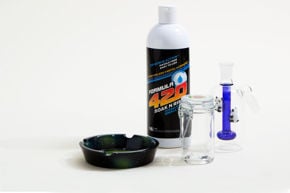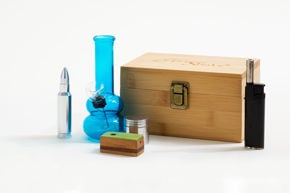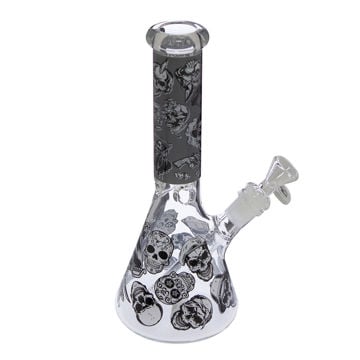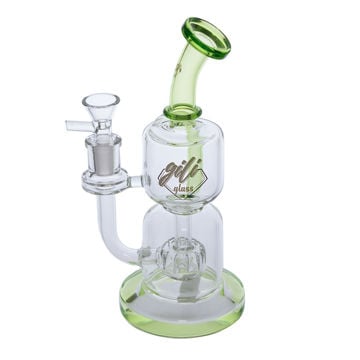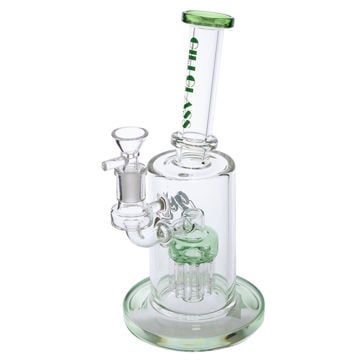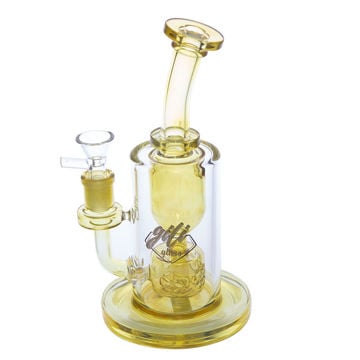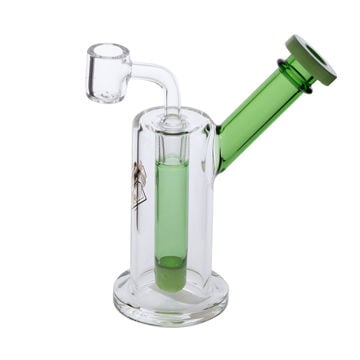Bongs & Water Pipes for Any Budget
Glass water pipes and bongs are more efficient, powerful, and easier on the throat and lungs than many other smoking methods, thanks to water percolation. Between glass and silicone water pipes, we've got the best selection on the web.
Smoking Outlet – Special Mystery Bong
• Material: Glass
• $50 and $100 Options
• Product Specifications Vary
Cali Cloudx – Ecosphere 8.5" Glass Mushroom Bong
• Mushroom Perc
• 14mm Female Joint
• 14mm Male Bowl Piece
• Borosilicate Glass
• Height: 8.5”
• Thickness: 4mm
Hi Kitty – 10" Straight Tube Bong
• Ice Pinch
• 18mm/14mm Diffused Downstem
• 14mm Male Bowl Piece
• Borosilicate Glass
• Thickness: 5mm
Gili Glass – 2-in-1 Tall Bong & Dab Rig Hybrid
• Double Chamber
• Sphere Perc, Diffused Downstem Perc
• 18mm & 14mm Female Joints
• 14mm Male Bowl Piece & Banger Nail
• Borosilicate Glass
• Height: 16”
• Thickness: 5mm
Koos – Iridescent 8" Glass Beaker Bong
• Ice Pinch
• Diffused Downstem
• 14mm Male Bowl Piece
• Borosilicate Glass
• Thickness: 4mm
Gili Glass – 8.5" Honeycomb Perc Tube Bong
• Fixed Diffused Stem Perc
• 14mm Male Bowl Piece
• Borosilicate Glass
• Thickness: 4mm
Gili Glass – 9.5" Whirlwind Showerhead Recycler Bong
• Showerhead Perc, Recyclers
• 14mm Male Bowl Piece
• Borosilicate Glass
• Thickness: 4mm
Gili Glass – Petite 7.5" Glass Beaker Bong
• Ice Pinch
• Diffused Downstem
• 14mm Male Bowl Piece
• Borosilicate Glass
• Thickness: 4mm
Alien Buddy – Silicone hand pipe
• Portable and Lightweight
• High-Quality Silicone
Guns Blazing Silicone Bong (Random Color )
• 18mm Female Joint, Glass on Silicone
• 18mm/14mm Diffused Downstem
• 14mm Male Bowl Piece for Dry Herb
• Material: Silicone
• Height: 11”
• Weight: 13.4 oz
• Silicone Thickness: 4mm
• Base Diameter: 3.75”
5" Mini Silicone Bong(Random Color)
• 14mm Male Banger Nail
• Silicone
• Thickness: 3mm
• Pattern and Design may vary
Gili Glass – 12.5" Tree Perc Beaker Bong
• Tree Perc, Ice Pinch
• 14mm Female Joint
• 14mm Male Bowl Piece
• Borosilicate Glass
• Thickness: 5mm
Gili Glass – 17" Double Tree Percolator Beaker Bong
• 2 Tree Percs, Ice Pinch
• 18mm Female Joint
• 18mm/18mm Diffused Downstem
• 14mm Male Bowl Piece
• Borosilicate Glass
• Height: 17”
• Thickness: 5mm
Gili Glass – Rainbow 15.5" Straight Tube Bong
• Ice Pinch
• 18mm Female Joint
• 18mm/14mm Diffused Downstem
• 14mm Male Bowl Piece
• Borosilicate Glass
• Thickness: 5mm
Gili Glass – The Equinox 9" Percolator Bong
• Tire Perc
• 14mm Male Dab Nail
• Borosilicate Glass
• Thickness: 4mm
Gili Glass – 8" UFO Perc Beaker Bong
• UFO Perc, Ice Pinch
• 14mm Female Joint
• 14mm Male Bowl Piece
• Borosilicate Glass
• Thickness: 5mm
Gili Glass – 11" Double Chamber Tree Beaker Bong
• Tree Perc, Ice Pinch
• 18mm Female Joint
• 18mm/14mm Diffused Downstem
• 14mm Male Bowl Piece
• Borosilicate Glass
• Thickness: 4mm
Gili Glass – The Ace Double Chamber Beaker Bong ( Random Color Shipped)
• UFO Perc, Ice Pinch
• Diffused Downstem
• 14mm Male Bowl Piece
• Borosilicate Glass
• Height: 9.5”
• Thickness: 5mm
Foggy – 19.5" Double Tree Percolator Beaker Bong
• 2 Tree Percs, Ice Pinch
• 18mm Female Joint
• 18mm/18mm Diffused Downstem
• 14mm Male Bowl Piece
• Borosilicate Glass
• Height: 19.5”
• Thickness: 5mm
Gili Glass – 13" Tree Perc Honey Bee Beaker Bong
• Tree Percs, Ice Pinch
• 18mm/14mm Diffused Downstem
• 14mm Male Bowl Piece
• Borosilicate Glass
• Thickness: 5mm
Graffiti Galore Mini Water Pipe
• 14mm Female Bowl Piece, Glass on Silicone
• 18mm Male Silicone Joint
• 14/18mm Silicone Downstem Perc
• Gender Changer, Nails for Concentrate, and Other Accessories Available
• Various Designs and Colors
• Height: 6.75”
• Weight: 5 oz.
• Base Diameter: 2.5”
Classic House – 6" Honeycomb Percolator Glass Hybrid
• Honeycomb Perc
• 14mm Male Bowl Piece
• Borosilicate Glass
• Thickness: 4mm
Gili Glass – 9.5" Patterned Leaf Beaker Bong
• Ice Pinch
• 18mm Female Joint
• 18mm/14mm Diffused Downstem
• 14mm Male Bowl Piece
• Borosilicate Glass
• Thickness: 5mm
Koos – 14" Patterned Beaker Bong
• Ice Pinch
• 18mm Female Joint
• 18mm/14mm Diffused Downstem
• 14mm Male Bowl Piece
• Borosilicate Glass
• Thickness: 5mm
Gili Glass – 10" Skinny Bottle Percolator Bong
• Bottle Perc
• 14mm Male Bowl Piece
• Borosilicate Glass
• Thickness: 4mm
Gili Glass – 9.5" Funnel Recycler Glass Bong
• Showerhead Perc, Recycler
• 14mm Male Bowl Piece
• Borosilicate Glass
• Thickness: 4mm
Gili Glass – Your Eyes 10" Showerhead bong
• Showerhead Perc
• 14mm Female Joint
• 14mm Male Bowl Piece
• Borosilicate Glass
• Thickness: 4mm
Gili Glass – Insomnia 16" Glass Straight Bong
• Ice Pinch
• 18mm Female Joint
• 18mm/14mm Diffused Downstem
• 14mm Male Bowl Piece
• Borosilicate Glass
• Thickness: 4mm
World War 1– 6" Old Generation Tank Silicone Bong
• Diffused Downstem Perc
• 14mm Female Joint
• 14mm Male Bowl Piece
• 14mm Male Banger Nail
• Including Dabber & Container
• Height: 4.5”
Totororo – 6" Silicone Water Pipe
• 18mm/14mm Diffused Downstem
• 14mm Male Bowl Piece
• Silicone
• Thickness: 3mm
Simple Rainbow – 6" Rainbow Beaker Bong
• Thickness: 3mm
• Rainbow color varies.
The Button – 6" Glass Bong
• Diffused Fixed Stem Perc
• 14mm Female Joint
• 14mm Male Bowl Piece
• Borosilicate Glass
• Thickness: 4mm
Gili Glass – 9.5" Patterned Beaker Bong
• Ice Pinch
• 18mm Female Joint
• 18mm/14mm Diffused Downstem
• 14mm Male Bowl Piece
• Borosilicate Glass
• Thickness: 5mm
Gili Glass – One Hand 8" Showerhead Recycler Bong
• Showerhead Perc, Recycler
• 14mm Female Joint
• Borosilicate Glass
• Thickness: 4mm
Gili Glass – 13" Inline Tree Percolator Bong
• Inline Perc
• Tree Perc
• 14mm Female Joint
• 14mm Male Bowl Piece
• Borosilicate Glass
• Thickness: 5mm
Gili Glass – The High Life 9" Tree Perc Bong
• Tree Perc
• 14mm Female Joint
• Borosilicate Glass
• Thickness: 5mm
Gili Glass – Hourglass 8.5" Showerhead Bong
• Showerhead Perc
• 14mm Female Joint
• 14mm Male Bowl Piece
• Borosilicate Glass
• Thickness: 4mm
Astronaut In the Universe – 5.5" Silicone Bong
• 14mm Female Joint
• 14mm Male Bowl Piece
Gili Glass – Inline Perc 11" Recycler Bong
• Inline Perc, Recycler
• 14mm Female Joint
• 14mm Male Bowl Piece
• Borosilicate Glass
• Height: 11”
• Thickness: 4mm
Rubber Rocket – 7.5" Portable Silicone Bong
• Fixed Stem Perc
• 14mm Female Joint
• 14mm Male Bowl Piece
• Thickness: 3mm
Gili Glass – 11.5" Straight Showerhead Tube Bong
• Diffused Downstem, Ice Pinch
• 18mm Female Joint
• 18mm/14mm Diffused Downstem
• 14mm Male Bowl Piece
• Borosilicate Glass
• Thickness: 6mm
Lean Back – 9" Silicone Hybrid Bong
• Fixed Diffused Downstem
• 14mm Female Joint
• 14mm Male Bowl Piece
• Silicone & Acrylic
• Thickness: 2mm
Mad Dinosaur – 5.5" Silicone Bong
• 14mm Female Joint
• 14mm Male Bowl Piece
Gili Glass – 6" Sidecar Dab Rig
• 14mm Female Joint
• Borosilicate Glass
• Basket Weave Perc
• Thickness: 4mm
The Microscope – 13.5" Rocket Perc Bong
• Rocket Perc, Dome Perc
• Borosilicate Glass
• Thickness: 5mm
• Blue Option: 14mm Female Joint; 14mm Male Bowl Piece
• Amber Option: 18mm Male Joint; 18mm Female Bowl Piece
Kung Fu Elephant – Silicone Hybrid Bong
• Diffused Downstem Perc
• 14mm Female Joint
• 14mm Male Bowl Piece
• 14mm Male Banger Nail
• Including Dabber & Container
• Height: 4.5”
Koos – 7" Shower Head Perc Dab Rig
• 14mm Male Banger Nail
• Borosilicate Glass
• Thickness: 4mm
- 1
- 2
About Water Pipes & Bongs
Bongs: The Classic Stoner Staple
Smoking from a hand pipe is nice and convenient, and even an old can or an apple can be used in a pinch, but nothing quite compares to the refreshing feeling of smoking from a water pipe. The addition of water to your smoking equipment makes each hit smoother, cooler and more enjoyable. Over time, we’ve moved from simple, straightforward bongs made at home, to a world where the best artists can command tens of thousands of dollars for functional glass art.
Beginners will have a ton of crucial questions about bongs, aka water pipes, like: Who invented bongs? How do bongs work? And most importantly, how do you know which bong is the best for you? We’ve collected a few of our most frequently asked questions, and answer them here.
Who Invented the Bong?
Water pipes for smoking have been around so long we don’t actually know exactly where or when they originated. Archaeological findings from Africa and Asia show that humans have been cultivating and smoking cannabis for thousands of years. There’s still heated debate on whether humans in Africa or Asia invented the bong first. Archaeologists have found smoking pipes made from stone, ceramics, and even mud!
The bong as we know it comes from Thailand. The Thai word “baung” refers to a tube or pipe made of bamboo, and the term was adopted by American soldiers who were exposed to the simple water pipes during the Vietnam war. Since then, the word “bong” is the most popular way to refer to filtered water pipes.
How Do Water Pipes Work?
What’s the deal with bongs anyway? Why is this form of smoking device so popular across the globe? It all comes down to percolation. The standard definition of percolation is when a liquid slowly passes through a filter, like coffee. With water pipes, percolation refers to the process of smoke being pulled through water and broken up into smaller particles.
A percolator is a component to your glass water pipe with holes or slits. As you inhale, airflow moves down the intake stem and through the percolator. The multiple openings in a perc are there to produce evenly sized bubbles of smoke and air which helps break up the nastier compounds. Water filtration also eliminates the harsh heat of dry smoking methods.
There are more types of percs than we can cover here, but they all serve the same purpose: To filter and cool your smoke.
Parts of a Water Pipe
Percs are just one component of a water pipe. Most water bongs share a similar anatomy and accessorize with bells and whistles. The basic anatomy of a water pipe is actually pretty simple.
Water Chamber: This is where the magic happens. The slits in a downstem or percolator have to be submerged in water to work. A larger water chamber usually means larger hits, and beaker bongs are the style of choice for heavy hitters.
Joint: This piece connects the water chamber to your dry herb. In a stemless water pipe, the bowl piece fits directly into the joint. In a beaker bong, the joint fits the removable downstem.
Downstem: The classic bong design includes a downstem. This tube of glass often contains diffusion slits as a form of percolator. A bong’s downstem fits into the 18mm joint, and the top opening narrows to 14mm for the bowl piece to fit in. Downstems are removable to make cleaning easy.
Bowl Piece: This little item holds your dry herb. Many bowl pieces have a small handle on them, making it easier to pull the bowl piece out of the joint and stop your hit from building any further. Bowl pieces come in a range of sizes to suit your needs.
Neck & Mouthpiece: The long tube above the water chamber is known as the neck, and the lip up top is referred to as the mouthpiece. Depending on the style of bong, the neck can be straight or bent.
Ice Pinch: Many classic bongs have an ice pinch or ice catch right above the water chamber. These indentations allow you to drop ice cubes into the neck, which cool your smoke directly as it passes over the freezing surface area.
To Buy Bongs Online, Consider These Factors
Body Style: Glass can be shaped into almost any shape you can think of, but for bongs, there are 3 main styles to consider.
- - Straight Tube: A cylindrical shape that remains consistent from the chamber to the mouthpiece.
- - Beaker: A stable cone-shaped chamber with a straight neck, usually including an ice pinch.
- - Percolator: This type comes in a variety of shapes, and can contain any style of perc.
Other styles you might want to consider are -
- Silicone: Unbreakable bongs with unmatched durability
- Recycler: A bong with multiple chambers connected by a tube to re-filter smoke through the chamber.
Joint Size: Glass joints can be made into any size, however, there are 4 standard joint sizes for bongs: 10mm, 14.5mm, 18.8mm and 29.2mm. The first three are by far the most common joint sizes, and the easiest to find replacement bowls and accessories for.
Bong Size: One of the most important factors to consider when buying bongs online is the size of the piece. Great big bongs can be an awesome aesthetic with powerful cooling, but aren’t ideal for travel. If you want something more portable, stick to a smaller piece that you don’t have to worry about breaking. Alternately, if you’re looking for an epic piece that will impress, the bigger the better!
At the end of the day, maybe you just want a bong that looks really cool. Treat yourself to a piece you’ll love to keep out on display. Who said you need to choose just one?
Learn More About Bongs & Water Pipes
- The Final Bong Percolator Guide: Learn the different types of percolator bongs, how they work, and which kind is right for you.
- The Ultimate Guide to Recyclers: There’s more to recyclers than just a basic attachment tube. Find out all the awesome ways recycler bongs can enhance your smoking experience.
- Why You Need an Ashcatcher: You might have heard about this smoking accessory, but did you know all the ways they can make your life easier?
- The Skinny on Swiss Percs: Everything you need to know about this popular and functional natural water pipe perc.
- 5 Liquids NOT to Put in Your Bong: Ever thought of putting something other than water in your bong? Choose wisely.


